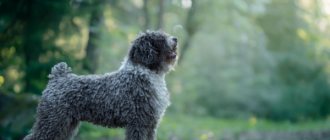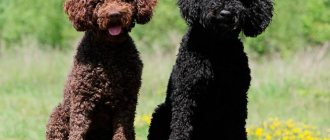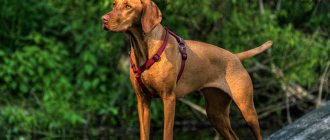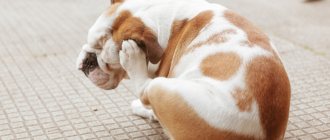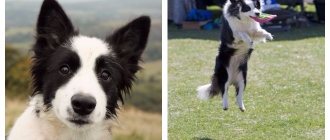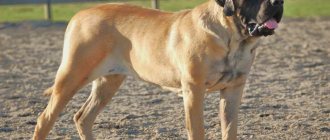History of the breed
Ancient China is considered the birthplace of pugs; this breed is mentioned in manuscripts dating back to the 5th century BC. The presence of these animals at home emphasized the nobility of their owners; accordingly, these dogs were kept by the nobility and simply wealthy people.
This type of dog came to Europe in the mid-16th century, first to France, then to Holland and England. These animals were very popular in European countries for about two hundred years, but later their popularity began to decline and in the mid-19th century, even Queen Victoria of England had difficulty finding one puppy of this species.
Pugs are quite an active breed of dog.
But already at the end of the 19th century, pugs began to be popular again, so in 1885 the first dog club of this breed arose, two years later an exhibition was held with their participation, and soon the requirements for dogs of this breed were officially established.
Features and description of the breed
Depending on their body structure, there are three types of pugs:
- Terrier or lightweight type, dogs of this species are considered the most attractive, their feature is an elongated neck and a straighter body;
Pug age 2.5 years
- The bulldog type is easily distinguished by the presence of a wide torso and oblique shoulder blades;
Pugs are prone to obesity
- Shar Pei type, this type of dog has a very long back and topline, this variety is considered inapplicable and is not recommended for breeding.
Pug in the meadow in summer
However, one of the main distinguishing features of all pugs is the presence of an unusual appearance, dark eyes, short legs and a crocheted tail. Another important distinguishing feature of the species is the presence of specific wrinkles on their muzzle; they must be symmetrical and not droop like a bulldog’s.
Thanks to these features, these animals are quite difficult to confuse with other dogs. Pugs have a rather soft, kind, imposing character and are perfect for people who prefer to lead a less active lifestyle or for owners who have decided to have a pet for the first time.
In addition, due to their non-aggressive nature and love of company, they will become excellent friends for children. A pug puppy, unlike an adult, is quite active and inquisitive, and only by the age of two or three does it acquire its inherent noble calm.
In general, pugs have the following characteristic appearance features:
The weight and size of a pug is 6-10 kilograms and 30-35 centimeters at the withers. The head of this breed is large, round with a short, blunt muzzle and wrinkles clearly marked on it.
The pug gets along well with other animals and children
The lower jaw is wider than the upper jaw, thereby clearly underbiting. The eyes of these animals are large, round, usually dark with a slightly pronounced bulge. The eyes of these dogs are widely spaced and are located in line with the black nose.
This type of dog has small, soft, rather high-set ears that fit tightly to the head. The neck of pugs is dense, strong, slightly curved with a well-developed scruff. The body of this breed is short, but strong with well-developed muscles, and its length is approximately equal to the height at the withers.
The tail is short and usually curled into a ring and held close to the body. Pugs have short but strong paws with separated toes. The coat of this breed is dense, short, and soft to the touch.
Pugs ask for treats
This type of dog comes in several colors, the most common being pale yellow, silver and black. The black pug is a rather rare phenomenon and its breeding began only at the end of the 19th century; unlike its lighter-colored relatives, this type of pug has a more active temperament.
Maintenance, care and feeding
The Hungarian Shepherd is very clean; it produces virtually no odor, even if it gets wet or sweats. During molting, the hairs do not fall out, but remain in twisted dreadlocks. A puppy under two years of age is constantly brushed.
An adult animal practically does not require this procedure. The owner separates the bundles with his hands to avoid matted tangles. This process is simple, but very long and exhausting.
The Komondor is bathed very rarely, once every three months, and sometimes once every six months.
The voluminous coat takes a very long time to dry, so after bathing the dog is monitored to avoid catching a cold.
Wool can take longer than a day to dry, even if surrounded by hair dryers. The owners of Hungarian Shepherds take them for walks in special overalls because their fur catches street dirt. In wet weather, it is recommended not to leave the house with your dog.
The Komondor's coat is not cut. This procedure is only necessary if the bundles drag along the road and get dirty: then they can be shortened a little.
Owners of working Komondors often shorten their harnesses in the spring because grooming the coat is challenging. However, such a measure deprives the pet of natural protection from bad weather conditions and predators. The low popularity of the breed is explained by the difficult care of its unusual coat.
The owner must provide the animal with the necessary amount of physical activity.
It is ideal if the pet has the opportunity to splash out energy in the yard of the house.
Nutrition
Pugs are quite unpretentious in food, although the owners of these pets still need to take into account a number of features when feeding them. So, due to their physiological structure of their skulls, feeding liquid food to these animals is quite difficult.
Pugs love food from their owner's table
In addition, it is important to remember that the pug breed is prone to obesity, and therefore it is necessary to strictly monitor whatever the animal overeats. It is recommended to feed your pet two or three times a day.
You can feed your dog raw or boiled low-fat meat (preferably raw) no more than 0.5 kg per day, you can also feed your pet with dry food, as it contains the vitamins and minerals necessary for the growth and development of the animal. Several times a week you need to give your pug vegetables and dairy products.
It is not advisable to feed this breed of dog the following types of food:
- Fatty foods, especially pork.
- Sweets and flour products in the form of buns, cookies and cereals such as rolled oats. You can give your pet 1-2 candies per month as a reward.
- Human food in the form of sausage, fried meat, etc., the animal will eat them with pleasure, but this can have a very bad effect on the health of the pet in the form of constipation, diarrhea, ulcers, obesity, etc.
Historical reference
This amazing dog has lived on Hungarian soil for thousands of years. Several interesting legends are associated with the origin of the breed. According to one of them, the Komondor breed is the result of crossing wolves and sheep. A more realistic version, based on scientific facts, says that the Hungarian Shepherd Dog arose as a result of a mixture of wolves and herding dogs.
The breed received its first name “Hungarian Shepherd” as a result of the fact that it accompanied the Hungarian tribes in their nomadic life. The name Komondor comes from the Italian “cane commodore”, which means “king dog”. The animal received such a majestic nickname due to its large size, aristocratic manners and unusual coat. Also related to the Hungarian Shepherds is the Puli dog breed.
The first Komondors served as shepherds. They were perfect for this role, being brave, resilient, decisive and capable of defending themselves from the enemy and preserving the owner’s property. Thanks to their appearance, they blended in with a herd of sheep and suddenly jumped out in front of the nose of an approaching wolf, which confused him.
The Komondor breed is quite common these days, especially in the United States of America.
Pug diseases
The average lifespan of pugs is 10-15 years, but lifestyle and various diseases greatly affect the dog’s lifespan. The main diseases that this type of dog is susceptible to are:
Pug age 4 years
- Obesity. Poor nutrition and a sedentary lifestyle can lead to your pet becoming overweight, which in turn will cause congestion in the joints, heart, liver and kidneys. To prevent obesity in a dog, it is necessary to strictly control food intake, not to overfeed the dog and take him for walks more often.
- Corneal erosion. Its symptoms are clouding of the eye and profuse lacrimation; in the later stages, a network of blood vessels is visible. Corneal erosion can be caused by injury to the eye, dirt or foreign objects getting into it. For recovery, you must take antibiotics prescribed by your veterinarian, as well as vitamin A.
- Encephalitis. This disease is inherited and manifests itself in the form of seizures, disorientation, blindness and eventual death. Unfortunately, there is no effective treatment for this disease yet.
- Epilepsy. This disease is also inherited and its symptoms are repeated seizures caused by brain damage. Treatment consists of a long course of special medications.
- Allergy. The Pug is predisposed to various types of allergies, such as seasonal, food or chemical. It manifests itself in the form of severe itching, redness, dandruff, and otitis media. When treating, it is initially necessary to understand what causes the allergy and protect the pet from it; in severe cases, the veterinarian will prescribe special antiallergic drugs.
- Respiratory diseases. Due to its small nose, the pug is susceptible to this type of disease. To prevent such diseases, it is necessary to reduce the time the animal spends outside in cold and rainy weather.
Pug price
You can buy a pug in several ways, either through an advertisement from private hands or in a specialized nursery. The first option is significantly cheaper, but there are risks that the new owner will be deceived.
A puppy in a pug nursery will cost the owner more, but here he will be presented with all the necessary guarantees, namely information about vaccinations, pedigree, and information about the pug’s parents.
Due to the specific structure of the muzzle, the pug often has problems with the eyes
In addition, it is possible to consult with nursery staff in case of possible problems. How much a pug costs depends largely on the purpose of purchasing a puppy; if it is needed for participation in dog shows and further breeding, then its cost will be 25-30 thousand rubles. If you just need a pet dog, then the price of a pug in a kennel will be 12-15 thousand rubles; from private owners, buying a puppy will cost 5-7 thousand rubles.
Basic pros and cons
Pros:
- excellent security guard;
- strength and endurance;
- excellent herding qualities;
- calm temperament, good nature;
- treat children well;
- easy to train;
- devotion to the owner and family.
Minuses:
- difficult coat care;
- desire to dominate;
- suspicious attitude towards strangers (this can also be considered a plus).
The Komondor is an original breed with its own peculiarity in the form of an unusual coat. It has its merits, and if the future owner is willing to devote a lot of time to raising, training the dog and caring for its unique coat, he may think about purchasing a puppy.
Additionally, check out the video that describes the Komondor breed:

